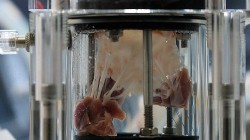Major advances in bioengineered heart implants
Europe has a shortage of trained scientists in the rapidly emerging areas of TE and RM. The EU-funded project TECAS (Towards tissue engineering solutions for cardiovascular surgery) developed a multidisciplinary and intersectorial training programme for early stage researchers (ESRs). Repair and replacement for a broken heart Sotiris Korossis, project coordinator, elaborates ‘The TECAS-ITN structured doctoral training in cardiovascular TE at a European level by creating a cross-European research and training infrastructure, further enhancing European competitiveness in TE and RM.’ The Initial Training Network (ITN) team focused on cardiac valve replacement/repair, myocardium (heart muscle tissue) reconstruction and patch graft angioplasty to repair large blood vessels. Researchers used biological tissues that were treated to remove their cells, with a view to producing acellular non-immunogenic scaffolds that they would not invoke an immune response on implantation. These scaffolds can then either implanted directly to the patient, or reseeded with the patient’s own cells and trained in the laboratory under physiologically relevant physical stimuli to acquire complete biological and biomechanical functionality prior to implantation. The success of the project is reflected in the number of developments for commercial exploitation, readily translatable to clinical practice. 'Specifically, the infrastructure has enabled the rapid translation of a semi-automatic pattern recognition method for histopathological assessment of images in the Hannover Medical School practice. Moreover, the developed sterilisation and preservation methodologies for decellularised valvular scaffolds are being used by Corlife oHG in production.' emphasises Korossis. To appear in the clinic shortly TECAS-ITN research has generated a number of disruptive technologies destined for significant medical impact. Particularly notable are flow bioreactors for the functional assessment of valve scaffolds to determine long-term fatigue and calcification as well as scaffolds for cardiovascular patching. ‘This,’ explains Korossis ‘together with a non-destructive method for quality control of seeded TE constructs, is expected to streamline the development and quality production monitoring of the scaffolds for safe clinical use, significantly reducing the need for animal testing.’ The three novel valve prostheses and the living myocardial patch developed in the project are expected to promote tissue remodelling and regeneration, reducing the need for costly revision surgery. Importantly, the calcification bioreactor and the patch enable monitoring of calcification and myocardial infarction respectively and new therapies can be studied in vitro for these conditions. TECAS-ITN research produced five patentable technologies, including an in vitro calcification system, anticalcification treatment for scaffolds, a decellularised pericardial percutaneous heart valve, and the pattern recognition method for quality control of tissue-engineering constructs. Emphasising the commercial potential, Korossis points out that ‘external companies have expressed interest in the exploitation of all five technologies, which will be commercialised once the relevant patents have been granted.’ Spreading the word on TECAS technology Wide dissemination includes 19 peer-reviewed papers with another 19 in preparation. In addition, an impressive total of 47 podium and poster presentations were made by the ESRs at major conferences. The ITN researchers have also published six Wiki articles. The TECAS consortium organised eight cardiovascular TE symposia in major conferences, whereas the ESRs organised and participated seven science fairs with exhibits, workshops and lectures. Five summer schools were held for secondary school students and teachers, which will continue to run annually. The educational net was extended to primary school workshops and seminars were held to inform patients about new advancements in heart valve TE. Korossis summarises TECAS’ significance. ‘Overall, the TECAS-ITN produced a cohort of translatable and enabling technologies that will produce significant and direct scientific, clinical and commercial benefits to a range of different stakeholders, including the wider academic and cardiothoracic surgeon communities, and the medical devices industrial sector. Patients will be the ultimate beneficiaries by receiving safer implants with personalised potential, reducing the need for revision surgery.’
Keywords
TE, heart valves, heart surgery, EU, TECAS, ESR

